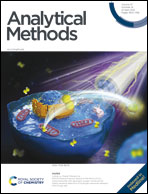Electrochemical sensor based on the Mn3O4/CeO2 nanocomposite with abundant oxygen vacancies for highly sensitive detection of hydrogen peroxide released from living cells†
Abstract
Based on the strategy of increasing the number of oxygen vacancies to improve the catalytic performance, we have developed a novel electrochemical sensor based on the multivalent metal oxides cerium dioxide and manganous oxide (Mn3O4/CeO2) for reliable determination of extracellular hydrogen peroxide (H2O2) released from living cells. The Mn3O4/CeO2 nanocomposite was characterized by high-resolution transmission electron microscopy, energy-dispersive X-ray spectroscopy, X-ray diffraction, and X-ray photoelectron spectroscopy. The electrochemical performance of the Mn3O4/CeO2 nanocomposite modified glassy carbon electrode (Mn3O4/CeO2/GCE) was investigated. Owing to the abundant oxygen vacancies and strong synergistic effect between the multivalent Ce and Mn, the sensor exhibited excellent catalytic activity and selectivity for the electrochemical detection of H2O2 with a low quantitation limit of 2 nM. Moreover, Mn3O4/CeO2/GCE exhibited excellent reproducibility, repeatability, and long-term storage stability. Because of these remarkable analytical advantages, the constructed sensor was able to determine H2O2 released from living cells with satisfactory results. The results showed that the Mn3O4/CeO2 sensor is a promising candidate for a nanoenzymatic H2O2 sensor with the possibility of applications in physiology and diagnosis.



 Please wait while we load your content...
Please wait while we load your content...